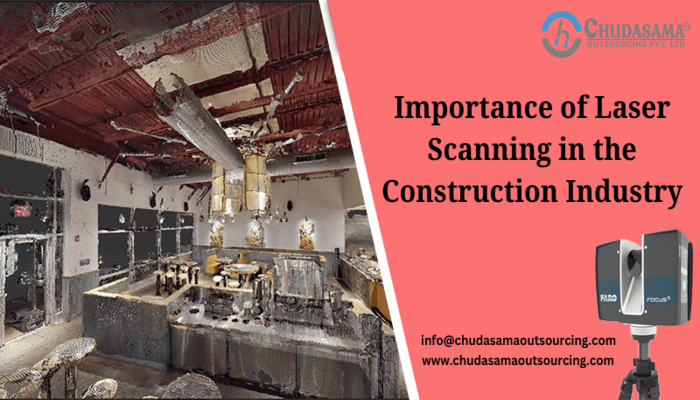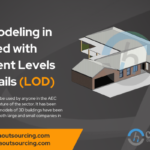The majority of the top businesses in the AEC sector depend on Scan to BIM Modeling to create BIM models that are incredibly thorough and precise.
The design of the building is presented in these BIM models, which are employed in as-built projects as well as the rehabilitation or restoration of ancient structures. Without tearing down historic structures or monuments, Laser Scanning aids in their reconstruction.
As-builts, digital construction process, comparing design ideas to as-built circumstances, quality management while construction, and BIM are some more applications for 3D Laser Scanning. Both inside and outside Laser Scan to BIM aid in developing intelligent 3D models and precise 3D surveys.
Laser scanning is a technique for collecting and mapping structures and spatial dimensions utilizing laser beams. The end result is a Point Cloud, a precise and accurate 3D depiction of the whole construction site or project.
Here is a detailed explanation of laser scanning. Numerous lasers are fired by a scanner in a full 360-degree arc, striking each thing in the area that is being scanned.
The scanner measures the angle and energy of the laser impulses as they collide with the objects, and then uses that data to model the area. Given how quickly and painlessly the operation is completed, Point Cloud to BIM Modeling has become increasingly popular.
Advantages of Using Laser Scanners in the Construction Industry
Companies in the construction business may reduce costs, speed up the construction process, and accurately assess dangers via laser scanning. In addition to these advantages, laser scanning provides:
-
Better Quality:
Engineering teams may obtain the most precise data regarding construction sites by utilizing the laser scanning method. Laser scanning has better precision when capturing interior and exterior features. This eliminates the need to redo exact architectural work afterward.
-
Lower Price:
Speaking about precision, quick information gathering, and exact measurement are the aspects that save expenses. Builder Space claims that using laser scanning may reduce construction costs. Besides that, you won’t need to send a general contractor to the location if you use Scan to BIM in your construction project.
-
Effortless Cooperation:
Cooperation and communication are made easier with the use of laser scanning. Teams may concurrently collaborate on a 3D virtual area survey, no matter where they are located. This facilitates better teamwork, understanding, and decision-making inside construction businesses.
-
Enhanced Designing and Planning:
Construction companies can use laser scanning to examine conflicts between existing site circumstances and recently updated design features. Additionally, it enhances planning, guarantees precise site dimensions, and identifies the resources the building business should employ.
Some construction projects need to renovate the existing architecture and areas. In this instance, design concepts are developed, improved upon, and realized via 3D laser scanning. In addition to other exact deliverables, this offers sections, floor layouts, and elevations.
-
Accelerated Speed:
With a single scan taking up to two minutes, laser scanning is faster than any tape measure. Additionally, since everyone can view all the acquired data in the office, laser scanning enables instant access to site specifics without the requirement to travel to a building location.
-
Increased Safety Precautions:
Construction organizations may enhance surveying procedure security with laser scanning. For example, mobile laser scanners can reliably capture measurements at a distance of 500 meters. If the construction crew is working in potentially dangerous places, it keeps them safe.
-
Improved Flexibility and Precision:
Contrary to automated laser scanning, manual labor is laborious and susceptible to mistakes. The use of technology reduces the likelihood of errors occurring during building. Additionally, laser scanning makes labor procedures more flexible by reducing the amount of time invested on construction sites.
-
Risk Reduction:
Human exposure to hazardous situations and highly radioactive zones is reduced by the laser scanning methods’ distant sensing capabilities and speedy data collecting. A laser scanner will accurately measure ducting and vaulted ceilings that are out of reach for humans. Site safety is considerably improved when one person has a laser scanner.
What Construction Work Can Laser Scanning Help With?
As you are already aware, laser scanning is utilized to map a project site and get precise data on a construction project in a matter of days rather than weeks. Additional issues that laser scanning can resolve in the building sector include:
-
Tracking the Development of the Construction:
Laser scanning makes it easier to monitor and gauge the precision of construction progress. This technique is useful for contract fulfillment verification and quality control as well.
-
Mapping the State of the Renovation Site:
The construction crew can swiftly assess the site conditions for remodeling projects thanks to 3D laser scanning. Finding faults in building plans also greatly improves their accuracy. Building site paperwork and architectural design correctness are both monitored through the use of 3D laser scanning.
-
Identifying Design Issues:
Design problems might occur as a result of new designs or modifications to a floor plan as a building project advances. Construction businesses can prevent these problems with the aid of laser scanning. The accurate delivery of outputs like elevations, sections, space planning, and more are also made possible by technology.
Conclusion
Both distant locations and intricate geometrical surfaces will be surveyed using Laser Scan to BIM Modeling Services. BIM models make it simpler to understand the gaps, design duplicates, or any alterations required in the new suggested design.
A potent method for recording and visualizing the three-dimensional geometry of real-world objects and surroundings is 3D Laser Scanning. This technology has a number of advantages for the construction sector, including increased precision, productivity, and protection.
The capabilities of laser scanning are expanding, and it offers a wide range of possible applications. Scan to BIM, a method that creates the 3D BIM Model of an original structure using the data obtained during the survey utilizing laser scanners and other such cutting-edge techniques, is one area of application for the AEC sector that is particularly intriguing.
Point Cloud to BIM Services will give you a sense of how quick and simple it is to turn a point cloud out of a laser scanning assessment into a BIM model of current structures.



